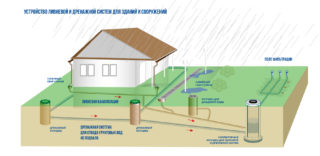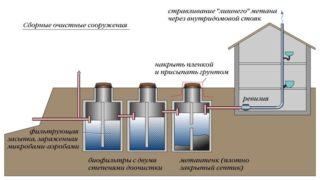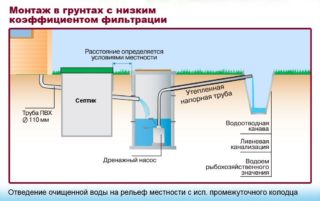Wastewater treatment plants are devices that represent a set of technical equipment for purifying drainage fluids to permissible levels with further discharge into water bodies, soil or central sewerage. It is possible to reuse them for technological and irrigation needs.
Types of sewage treatment plants
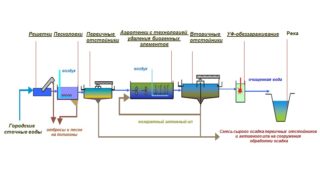
Cleaning devices are subdivided into city and local. The former receive a mixture of household waste water from city residents, industrial liquid waste from industrial facilities, as well as rain and melt water.
Local wastewater treatment plants are installed at industrial facilities to purify wastewater from the main contaminants before being discharged into the central sewerage system or reused. Local autonomous cleaners are installed in personal plots.
The device of sewage treatment plants is diverse and depends on the type of wastewater and the degree of its pollution. The complex can consist of the following blocks:
- mechanical assemblies;
- biological treatment plants;
- ion exchange devices;
- oxygenation apparatus;
- filters for adsorption;
- equipment for electrochemical and physical-chemical cleaning;
- installations for disinfection.
Purification equipment includes containers for the accumulation, storage, processing of the filtered sludge.
The principle of operation of treatment facilities of the centralized city sewage system:
- Wastewater treatment is performed mechanically. Contaminants are trapped thanks to special grates and sand traps.
- A more thorough cleaning is performed with a membrane device. In the sump, suspended solids are separated and mineral impurities are removed.
- For further cleansing, biological agents are used. Under the influence of active bacteria, organic compounds in the contaminated liquid decompose. The effluent passes through a biological filter. The result is sludge and gaseous compounds.
At the final stage of disinfection, additional chemical reagents are used. The resulting water can be used for technical purposes.
Storm sewer
The stormwater sewage treatment system includes:
- roof drainage;
- funnels and gutters that direct and transport moisture to a storm drain;
- a system of pipe sections and trays that transfer water to a storage tank or a nearby ravine.
Sand traps with containers for garbage collection are installed in various parts of the transportation system. They function as a filter and require systematic cleaning.
Local facilities
- Cesspools. These are the simplest VOCs and can be sealed or drained. Allowed only for small houses and summer cottages.
- Septic tanks are sealed tanks into which sewage drains are discharged. Anaerobic microorganisms live there, processing sludge and contributing to water purification.The liquid after the septic tank requires additional purification, for example, with the help of a biofilter, before it is discharged into a pond or soil.
- Aeration tanks. These are hermetically sealed installations with forced aeration. To process the liquid more efficiently, activated sludge containing the necessary microorganisms is used.
For deep cleaning, sewer stations and bioreactors consisting of blocks and modules are mounted. Plants of this type reduce the concentration of sludge in the water after treatment and protect the environment and human health. They bring the purity of the waste liquid to 98 percent, which means that it can be recycled. Structures are mounted in factories or in areas near residential complexes and large cottages.
Installation selection
When choosing a suitable purification system, take into account:
- total daily water use;
- the type and principle of operation of the sewer installation;
- location of the object.
The functioning of some installations can be carried out in full autonomy. Others will need electricity or other forms of energy to operate. There are devices, the use of which is unacceptable when groundwater is near.
Design features
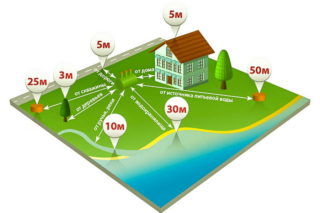
When creating a scheme for the location of treatment facilities, it is required to provide for the risks of operating the installation. Each type of sewage treatment plant has its own pros and cons. When selecting, it is necessary to proceed from the application parameters:
- the likely volume of wastewater that will enter the treatment tank daily;
- the use of the structure - on a permanent or seasonal basis, or only on weekends;
- system performance;
- geological conditions of the site location;
- the level of subsurface sources and the freezing point of the soil.
If it is planned to build a large house for a large family with the equipment of several sanitary facilities, it is recommended to build an autonomous sewage system. If you are choosing a unit for a summer cottage or a small house, an ordinary septic tank is enough.
Regulation on sanitary and building codes
The rules for the placement of treatment facilities are specified in SNiP 2.04.03-85 and SanPiN 2.2.1. To avoid conflict with sanitary and other supervisory services, you need to take into account the requirements prescribed in these regulatory codes, and also prepare a package of documents:
- ownership or lease agreement;
- a diagram of the location of the point where the installation of the treatment plant is planned;
- compliance with existing sanitary standards;
- technical conditions for the use of water resources;
- information on the volume of used and disposed water;
- project documents;
- description of the filtration system and sewage disposal.
You will also need permission from the sanitary and epidemiological station. In case of violation of sanitary standards, the owner can be brought to administrative responsibility.
Installation work
- Project creation.
- Site inspection and determination of its readiness for installation.
- Construction of the device.
- Connection of installations to communication networks.
- Start-up and adjustment works, adjustment and adjustment of automatic equipment.
- Testing and delivery of the object.
Determination of the full scope of installation work depends on the terrain and the design of the treatment plant.
When drawing up a device diagram and subsequent installation, they are guided by sanitary and building codes.
If you have to use a sewer truck to pump out waste, you will need to equip a free access to the storage tank.
Modern sewage systems are convenient devices for efficient wastewater treatment. When used correctly, they will provide comfort to residents of houses and business owners and will prevent environmental pollution of the area.

